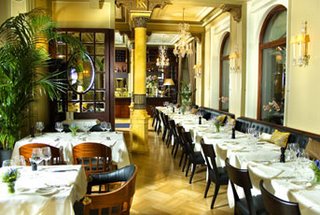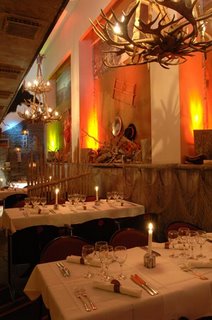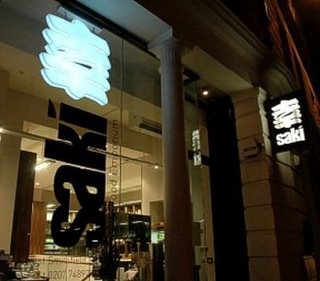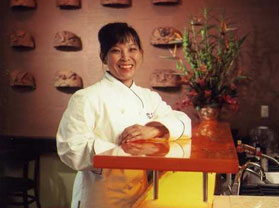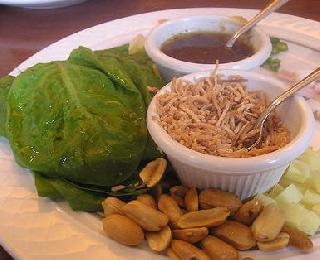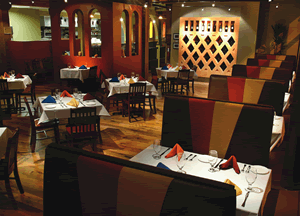So in the end, I didn’t update at all during my visit to New York – apologies if you were checking, but I hope you’ll understand. This was my first trip to the city, and I found myself doing things a long way from my hotel room from the moment I closed the door every morning until I collapsed, exhausted, into the Kitano hotel’s cloudlike embrace every night. Simply put, there is an awful lot of very entertaining stuff to do in New York, from the museums, the architecture, the shopping, the jazz – and the very, very good food – and I found myself much too busy enjoying myself to blog.
RUB BBQ (an acronym, this; spelled out, RUB means Righteous Urban Barbecue) is…well, righteous, and urban, and a barbecue joint. (208 W. 23rd St., New York, NY 10011, nr. Seventh Ave.) I do like restaurants which tell you what they do on the tin. This place is about Kansas City-style barbecue: fat, woodsmoke and the charred crispy bits best eaten when you are young and not prone to heart attacks. It’s no-nonsense food, served up in no-nonsense style on waxed paper dishes with pickle chips and hunks of sweetly pappy Wonder Bread – a strangely good accompaniment for smoky, salty, spicy barbecue. Leave any dietary concerns at the door, because the best stuff on offer here is unshamedly fatsome and entirely lacking in vegetably vitamins.
The meat is freshly smoked daily in set quantities, and this sometimes leads to certain items running out surprisingly early in the day (on our first visit they’d already run out of burnt ends by 6pm). I’m not sure whether this is a dastardly ploy to get you back in the door in the hope of finding what you were after – if it is, it certainly worked on me.
There is an appetiser on the menu called BBQ Bacon Chunks. I like bacon, I like barbecue, and I am partial to the sort of food that comes in chunks, so this was a no-brainer. A waxed paper dish of triple-smoked, thumb-sized rectangles of obscenely fat belly pork turned up, cooked to a melting crisp. “Good God, these things must be bad for you,” said Dr W, popping them in his mouth one by one in a sort of porky trance. “Mmmurgle,” I agreed.
Burnt ends are the blackened, fatty end of a beef brisket, cooked until the fat metamorphoses into a charred and friable, tender magic. Portions here are large, and I am still not quite sure how I managed to absorb a whole plate of the things into my person, but the burnt ends were one of those things it’s simply impossible to stop eating. Szechuan smoked duck was good, but not as good as the pork and beef on offer. Its mahogany, lacquered skin was simply gorgeous, all the fat underneath rendered out, but the meat was uninteresting, and not as moist as it could have been.
Table sauces include two barbecue sauces, one mild and one spicy, ketchup and vinegar. The pulled pork (see my recipe for pulled pork here) needed a good dollop of barbecue sauce to liven it up, but once it had been anointed was tender and tasty, with some lovely BCBs (Burnt Crispy Bits). Brisket from further up the joint than the burnt ends was leaner, and Dr W’s favourite cut on offer. He tiled the tender slices on a piece of Wonder Bread, added some of that spicy barbecue sauce and ate the whole thing as a sort of heart-attack sandwich. What’s going on here? Wonder Bread in its natural state is a soft, sugary abomination, but is weirdly delicious presented like this. Perhaps there is something in the rub.
Because if there is something in the rub, the rub itself is in everything. On every meat, and it also found its way into all the accompaniments we tried – onion strings were battered and fried, then sprinkled with the sweetly spicy rub. It flavoured the coleslaw (making it too sweet for my tastes – but you may wish to ignore what I have to say here, given that pieces of bacon fat the size of my thumb are to my tastes), was scattered all over the fries, and spiked the beans. Those beans beat me – they just tasted too much to enable us to eat more than about a spoonful each, and that rub really made them sweeter than I could manage.
Staggering out of RUB after our second visit, five times fatter than I was when I went in the first time, I found I had a greed-induced stitch in my side, and so stopped in a café to recover. Gazing out of the window, I locked eyes with Rupert Everett, craggily walking a dog. Glorious barbecue and surprise movie stars. I really like this city.


